|
As soon as the weather began to get warmer, we
started noticing lots of signs of Spring around our community. Flowers
were blooming, trees were growing new leaves, people were flying kites,
and insects were being found. Everyday on the playground, someone in our
class finds some sort of creepy crawly, like beetles, caterpillars, and
ladybugs. This led to our study of insects – we found these small animals
to be very interesting!

To begin our study, we explored what makes an
animal an insect. We learned that all insects have three main body
parts. Here’s a song we sang to help us remember these parts:
(Tune: For
He’s A Jolly Good Fellow)
My
head is starting to wiggle
My
head is starting to wiggle
My
head is starting to wiggle…
Around, and
around, and around.
(Repeat, substituting head with the other parts: thorax and abdomen)
When singing this song, we worked in groups of
three. The first student was the head, the second student was the thorax,
and the third student was the abdomen. By using three students, we had an
instant insect…complete with six legs!!
Sometimes we got confused about the order of the
three body parts. We knew the head came first, but the thorax and abdomen
were hard to remember…until Mrs. Madden showed us a trick to help.
If you place the body
parts in the wrong order (Head,
Abdomen,
and Thorax)
– your insect will be wearing a HAT
and insects never wear hats!!
After learning the characteristics of insects,
Mrs. Madden gave each student a bag of yummy treats to use in making their
own insect. The bags included 3 large marshmallows, six pretzel sticks,
two small pieces of licorice, 2 potato chips, and lots of peanut butter.
She told us beforehand that the peanut butter was for helping our insect
parts stick together, but that was the only information she would give
us. We had to use our knowledge (and the chart we made the previous day)
to decide which “treats” should make which parts of the insect.
|
Body Part |
Human |
Insect |
| Abdomen |
1 |
1 |
| Legs |
2 |
6 |
| Arms |
2 |
0 |
| Wings |
0 |
2 |
| Thorax |
0 |
1 |
| Head |
1 |
1 |
| Antennae |
0 |
2 |
Although there were lots of different strategies
at the beginning, we finally were able to decide just how to build our
insect correctly.

During writing workshop, we used story starters to
help us begin writing creative stories about the insects we were studying.
The Magic Anthill
By Dylan
One day I found an
anthill. It was fun watching the ants come and go. I sat by the anthill
for a long time. It had
ants coming and going. I saw a few ants
carrying a potato chip. It was fun to watch them take it into the
anthill. But when they got it half way in, it got stuck. So all the ants
came out and sat on it. It fell in very fast. I wanted to see if it made
it all the way in, so I peeked in. Then all of a sudden, I turned into an
ant. I walked right into the anthill. It was a very tight space. I saw
little rooms. In one room I saw a lot of crumbs and seeds for the ants to
eat. In another room I saw a queen ant. It was the biggest ant I’ve ever
seen. In the room with the queen ant there were other ants carrying eggs
out of the room. They took them to another room where other ants were
taking care of them. Then I began to think maybe all the ants were really
people, like me. All at once every ant went out of the anthill, so I went
too. We went to some people having a picnic. Every ant started to pick
up crumbs, so I did too. We went single file back to the anthill. Right
as I was about to go into the hill, I turned into a person again. I said,
“Boy! What a fun adventure!”

Dragonfly
By Chadi
When I first heard the
word dragonfly, I imagined what one would look like. Let me describe the
appearance of my dragonfly…I thought
that it was a dragon who could fly. I also thought fire came out of his
nose and mouth. I once thought that it would be big enough for me to fly
on. I thought they were green, blue, yellow, purple, and orange. Then
one day my mom showed me what a dragonfly looked like. Now I know what a
dragonfly really looks like.

Betty
Butterfly’s Party
By Catherine
“How
can I tell Grassy Grasshopper to watch his manners?” thought Ladybird
Beetle. “I really don’t want him spitting on my floor, especially during
the birthday party that I’m giving Betty Butterfly.”
Maybe I should tell Grassy Grasshopper to
stop spitting on my floor or he doesn’t get to go to Betty Butterfly’s
birthday party! So Ladybird Beetle went to Grassy Grasshopper’s house and
climbed up on the leaf. But when she got to the top…he wasn’t there! “Oh
my goodness,” cried Ladybird Beetle, “he’s not home. But where could he
be?” Suddenly Lucy Ladybug ran from out behind a bush and said, “I saw
him on a butterfly, headed north!” “But …but why would Grassy Grasshopper
do something like that?” “Maybe you hurt his feelings.” “Hurt his
feelings? If I hurt his feelings then I’ll have to say sorry!” Just
then, a butterfly flew down and said, “I know where they went. I saw them
in the treetops. I’ll take you there!” So Ladybird Beetle and the
butterfly flew over the Grassy Grasshopper. “Grassy Grasshopper, I’m
sorry. Can you come to the party?” asked Ladybird Beetle. “Sure I can!”
said Grassy Grasshopper. The next day was the party. Grassy Grasshopper
was the first insect there and he didn’t spit on the floor!

During our research time, we found some amazing
insect facts. We illustrated some of our favorites in Kid Pix Deluxe.
Here are just a few:
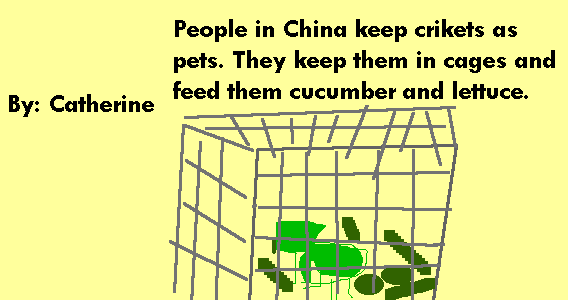
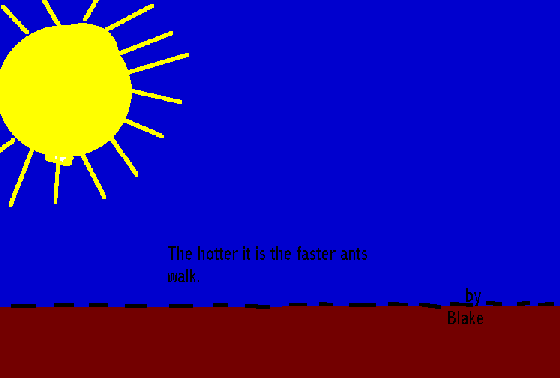
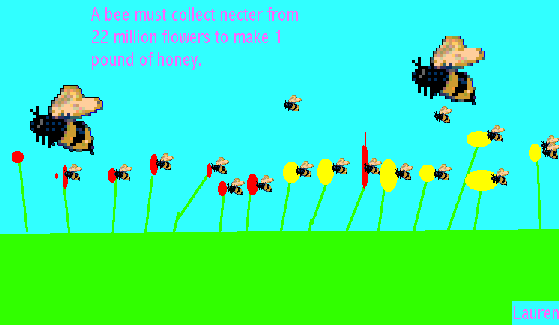
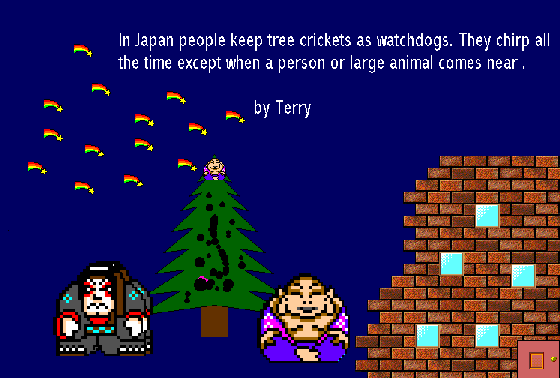
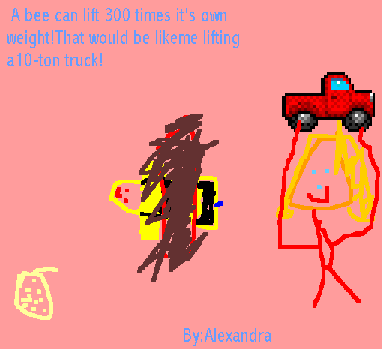
At the end of our study, we voted on our LEAST
favorite insect. Although, we like most of them, there were several that
we still just did NOT like!

Standards
Language Arts: Strand 1: Reading - Using Language to Learn
The reader:
listens and follows written and oral directions
differentiates between fantasy and reality
compares and contrasts
The writer:
communicates ideas clearly
revises for clarity/logical order
uses the writing process
Science Standards
II Life Science (animals)
a. 1. Organisms have basic needs
a. 2. Organisms can survive only in environments in which their needs can
be met/
b.1. investigate and understand that animals go through a series of
orderly changes in their life cycles
b.2 classify animals based on their similarities
c.1. investigate and describe ways in which animals interact with each
other and with the environment
Technology Standards:
1 - 1.4 Open, navigate, and close curriculum-based software programs
3 - 3.2 Create, revise, edit, save, and print a document
3 - 3.3 Utilize basic paint/draw tools

|











